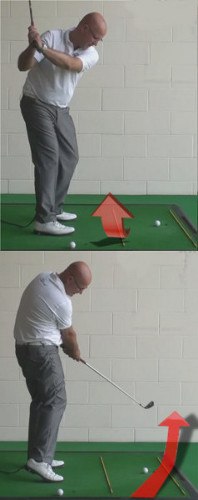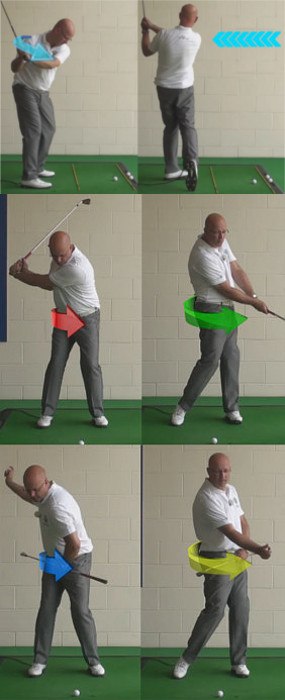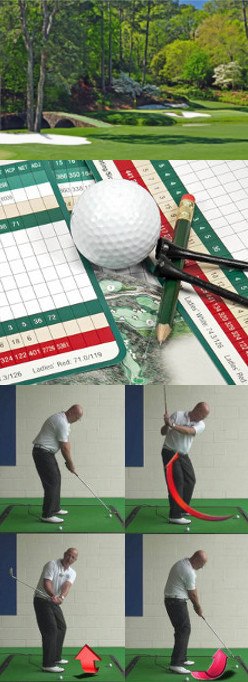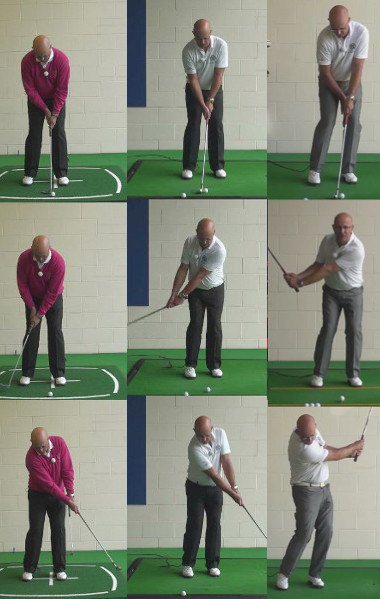The transition from backswing to downswing is one of the key moments in the golf swing.

If you get the transition right, you will be well on your way to a solid strike and a great shot. If you make a mistake, however, it’s going to be nearly impossible to save the swing in time to achieve a decent result.
It’s probably no surprise that professional golfers tend to do a great job of navigating the transition while amateur golfers tend to struggle. Pros are able to seamlessly change directions, placing the club in the right spot while gradually building speed from the top all the way down into impact. For amateurs, the story usually looks a little different, as the transition is often awkward and minimal speed is developed by the time impact arrives.
So, how can you improve your transition to function more like a pro move? That’s what we are going to address in this article. Make no mistake – it’s tough to improve your transition, and you’ll have to put in plenty of work on the range before you can expect to see progress. With that said, improving your transition is one of the biggest steps you can take toward improved ball striking, so it’s worth the effort.
All of the content below is based on a right-handed golfer. If you happen to play left handed, please take a moment to reverse the directions as necessary.
Understanding How the Transition Works

Some of the problems that amateur golfers encounter during the transition come down to nothing more than a lack of understanding. If you don’t know what you should be trying to do, it’s pretty tough to actually get it done. Before you get out to work on improving the way you transition from backswing to downswing, the first step is grasping exactly what you’re trying to accomplish. With a clear picture in mind, making improvements will become far more likely.
The main keys of a proper transition are listed below.
- Shoulders have to finish. If you learn only one thing from this article, let it be this – you need to let your shoulders fully complete their turn away from the target. Cutting the shoulder turn off early is an extremely common mistake in the amateur game, and it is an error that even troubles professional players from time to time (especially under pressure). If you are going to consistently strike accurate, powerful shots, you’ll need to make a full shoulder turn. It’s just that simple. Now, it’s important to understand that a full shoulder turn doesn’t mean the same thing for every player, so don’t worry if you are falling short of the turn achieved by others. Some players have a relatively short turn, while others have a huge turn – it’s possible to play good golf either way. What’s essential, however, is that you complete your own turn time after time. Cutting your shoulder turn short is going to lead to a number of problems, including lost power, a poor-quality strike, and even the possibility of a slice. As you work on improving your transition, you might be tempted to rush into this part of the swing. Don’t make that mistake – the transition is important, but it should not come at the expense of a great turn. There is actually some overlap between the backswing shoulder turn and your transition move, and we will get further into that discussion later in the article.
- Patient hands. Rushing the hands down toward the ball from the top of the golf swing is a common mistake. The average amateur golfer gets to the top of the swing and thinks that the first thing to do is force their hands back down toward impact. And, to be fair, that line of thinking does make some sense. After all, you need to get your hands back down there eventually, so why not get right to it? The problem with this approach is that it robs you of the opportunity to build speed in your swing. Forcing your hands toward the ball before your body has had a chance to turn toward the target it not going to lead to a powerful strike. Instead, you should be letting your lower body lead the way, while your hands stay back and wait their turn. This will feel nearly impossible at first, as the compulsion to hit at the ball with your hands will be strong. If you can be patient, however, you’ll be rewarded with more power than you’ve ever had through the hitting area.
- Focus on rotation. One aspect of the swing that tends to confuse amateur golfers is the issue of lateral vs. rotational movement. Some players seem to think that they need to move significantly from side to side in order to hit good shots, which is just not the case. The golf swing is a rotational motion more than anything else. With that said, there is a bit of lateral movement involved, which tends to complicate things. As you arrive at the top of your backswing, your weight should be slightly favoring your back foot – the right foot for a right-handed golfer. So, from there, you need to move a little bit back to the left while also turning aggressively toward the target. Blending those two moves can be tricky. You don’t want to slide laterally while neglecting your turn, but you also don’t want to turn in place and hang back on your right foot. So, what’s the solution? For most players, focusing on the use of the left hip to start the downswing is going to make a world of difference. As you near the top of your swing, think about turning the left hip open toward the target. Most likely, if you commit to this move, you’ll slide a bit left while also turning to the left – which is perfect. That’s not to say it will be easy to learn this move but making the left hip your focal point should be a great step in the right direction.
With just the three points above, you should already have a clearer picture of how the transition works. You need to make a full turn with your shoulders, keep your hands back at the start of the downswing, and let your left hip work for you. Players who check off all three of those points successfully will be well on their way to quality ball striking. As is always the case in golf, making progress with your swing is always going to take longer than you expect, so be patient as you work on improving your transition. As long as you are seeing little signs of progress along the way, stick with it and look forward to playing some of the best golf of your life in the near future.
The Essential Overlap

We mentioned earlier in the article that overlapping your backswing and downswing is an important element of the transition. Now, we’d like to take a closer look at that point. Golf is too complex to say that there is any one ‘secret’ to hitting great shots. However, if you had to point at one thing that the pros consistently do better than their amateur counterparts, it would be blending the backswing into the downswing. With a smooth transition, building speed and striking the ball cleanly becomes much easier.
When we say that the backswing should overlap with the downswing, we mean that the downswing should start just before the backswing has been completed. The swing would be awkward and disjointed if you required your body to stop moving back entirely before you let anything start to move toward the target. If you have ever noticed and professional golfers are able to hit powerful shots while making it look like they are swinging easy, this is how they do it. The downswing starts before the backswing has ended, and the final product is a smooth, consistent, powerful action.
As you work on trying to time up your transition just right, the two elements you will want to monitor are your shoulders and your left hip. As mentioned previously, you need to get all the way through your shoulder turn to hit good shots, and you also need to use your left hip effectively. The best time to start your left hip moving toward the target is just prior to the completion of your shoulder turn. If you get it just right, your shoulders will continue on and finish their turn even though your left hip has already started moving. Then, your upper body will gradually be pulled into the downswing as a result of the motion that your left hip has initiated. It’s a beautiful thing when done correctly, but it’s not easy to master.
The best way to get started working on this part of your swing, as is so often the case in golf, is to start small. During an upcoming trip to the driving range, work on hitting short shots with one of your wedges. Even if you are only hitting the ball 50 yards or so, you can still work on learning how the transition should feel. Turn your shoulders slightly away from the target, start your left hip to begin the transition, and let the club swing through. The key word here is ‘smooth’. You should be working to develop a smooth action that blends your backswing and downswing nicely. As long as you start small, it shouldn’t take too long before you start to see decent results.
Perhaps the hardest thing about this whole process is to remain patient while your build your skills up naturally. Once you get comfortable hitting a soft wedge shot with a smooth transition, you may quickly jump ahead to reaching for your driver and giving it a whack. Don’t do it! The timing involved in a full driver swing is far more advanced than what is needed to hit a wedge. As hard as it may be, maintain your patience and work your way up through the bag over the course of several practice sessions. It will be hard to be so patient, but your long-term results will be better for it.
Taking Your Transition to the Course

Every experienced golfer knows the struggle to trying to take their game from the range to the course. You go out to the range to work on something, make some progress, and get excited about what it will mean for your next round. Then, you head out to the course, and play far below the level that you expected. What happened? How did your round go so wrong when you were hitting the ball nicely during practice? Golf is a hard game and taking your improvements from the range to the course is a huge challenge.
The issue comes down to trust. On the range, you don’t have to worry much about the results of your shots, because there is always another ball waiting right there for you to try again. That’s not how it works on the course. If you hit a bad shot, you’ll have to go track down the ball and try again. Your score can add up quickly as you struggle, and it will be tempting to give up on your swing changes and go back to your old methods. You need a significant level of trust in your new and improved swing to stick with it on the course, which is why so many people get stuck and never manage to have the breakthrough they imagined.
So, is it hopeless to strive for improvement? Of course not – you can improve, and you can see those improvements pay off on the course, but you will need a plan. The points below should help you move from the range to the course more successfully as you strive to create a better transition in your swing.
- Pick the right time. You are going to need to log plenty of practice before you bring your new transition to the course. So, with that in mind, don’t start working on this in the middle of a busy summer of golf events. Rather, try to work on your swing improvement in the off-season, when you will have time to hit the range without a looming tee time in the back of your head. You may even want to tell your regular golfing buddies that you are going to be off the links for a while as you work on making this improvement. It might not be much fun to stay off the course for a bit, but the payoff could be a big one in the end.
- Put down the scorecard. This is another step that might be hard to take but consider leaving the scorecard behind for your first few rounds after you’ve made this swing adjustment. Keeping score is automatically going to put pressure on you to perform, even if you aren’t competing with anyone else. Try to look at your first few rounds as an extension of what you were doing on the range. You are still working on creating a better swing, only now you are doing that work on the course instead of on the practice tee. It is still possible to enjoy your round without keeping score, and the lower level of pressure will make it easier to bring your new and improved swing to the course successfully.
- Play alone. For many golfers, teeing it up is an opportunity to be social. And that’s a great thing! One of the best aspects of golf is the camaraderie you get to build with your fellow players. With that said, there is nothing wrong with playing solo from time to time, especially as you try to remake your golf swing. Just as keeping score can add pressure, so too can playing with other people. Pick a quiet time at your local golf course to get out by yourself and work on your game without the stress of anyone else watching you swing. Soon enough, you’ll have renewed confidence in your game and you will be able to enjoy playing with your group once again.
There is no denying the fact that taking an improved swing from the range to the course is a tall order. We hope the three tips listed above will help you be successful as quickly as possible in this pursuit.
Short Game Transition Issues

The transition that you will use for your short game shots is much simpler than what takes place during the full swing, but it needs attention nonetheless. You need to make a smooth transition on your putts and chip shots in order to get consistent results. To help you get on the right track in this area of your game as well, we’d like to offer up some basic points related to the transition in the short game.
- No lower body action. This is a key point, so we want to make it the first one on our list. When hitting a putt or chip shot, you should be keeping your lower body quiet while your upper body does the work. So, with that said, you won’t be turning your left hip toward the target to start the forward swing, or anything like that. You’ll simply want to build a solid stance with your lower body at address and then hold that position from the start of the swing on through to the finish. If you can do a great job of creating stability in your lower body on your short shots, you might be surprised to find how much easier it will be to hit solid putts and chips.
- Soft hands are essential. If your left hip is the key to the transition in the full swing, it’s your grip pressure that is the key in the short game. You should be holding lightly onto the club for the majority of short game shots, with only a few exceptions (such as bunker shots or shots from the deep rough, where you’ll need more grip pressure). If you maintain a light grip, it will be far easier to make a smooth transition and avoid the sudden, abrupt change of direction that gives so many players trouble. Do you feel like many of your current short game shots are rushed during the transition, making it hard to control your distance? If so, softer grip pressure could go a long way toward solving those issues. Without as much pressure in your fingers, your bigger muscles will be forced to take over control, and you should achieve more consistent results.
- Head perfectly still. It is during the transition that you will be tempted to move your head a bit in order to look up and see where the ball is going. Of course, this doesn’t do you any good, as looking up before the ball has even been struck is only going to lead to problems. Make it a point to keep your head still and your eyes on the ball all the way through the swing, including during the transition. So much of your success in the short game is going to come down to doing the fundamental things correctly, and keeping your head still is a huge piece of that puzzle.
Improving your transition won’t come easy, whether it is the full swing or the short game, but the rewards will be significant if you manage to make it happen. In the full swing, a solid transition will help you hit the ball farther, it will help you play under pressure, and it will lead to more accurate shots. On the short game side of things, you’ll have better speed control and make better contact. Across the board, you’ll be a better player if your transition is working properly. Thank you for taking the time to read this article, and good luck out there!





